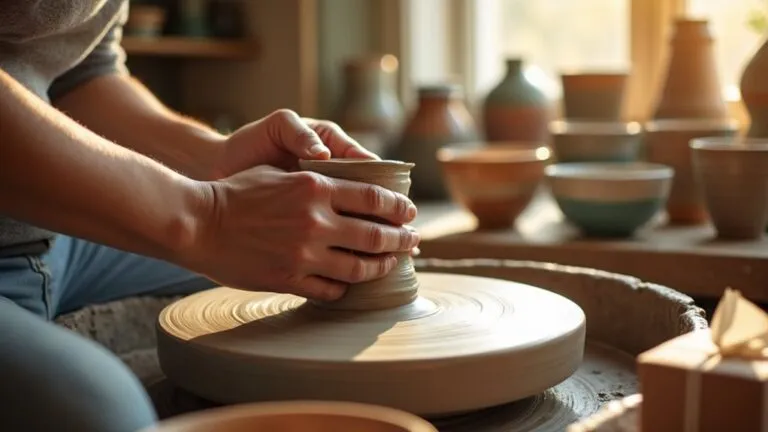Handmade pottery is commonly called artisanal ceramics, but you'll also hear terms like studio pottery, handcrafted ceramics, or ceramic art. These pieces are created through various techniques, including wheel throwing (using a potter's wheel) and hand building methods like pinch pottery, coil building, and slab construction. Each piece tells its own story through unique marks, from the artist's fingerprints to distinctive studio stamps on the base. Whether you're looking at ancient earthenware from 30,000 years ago or modern stoneware vessels, handmade pottery captures the essence of human creativity and craftsmanship. There's a fascinating world of techniques and traditions waiting to shape your understanding of this timeless art form.
Artisanal Ceramics Through History
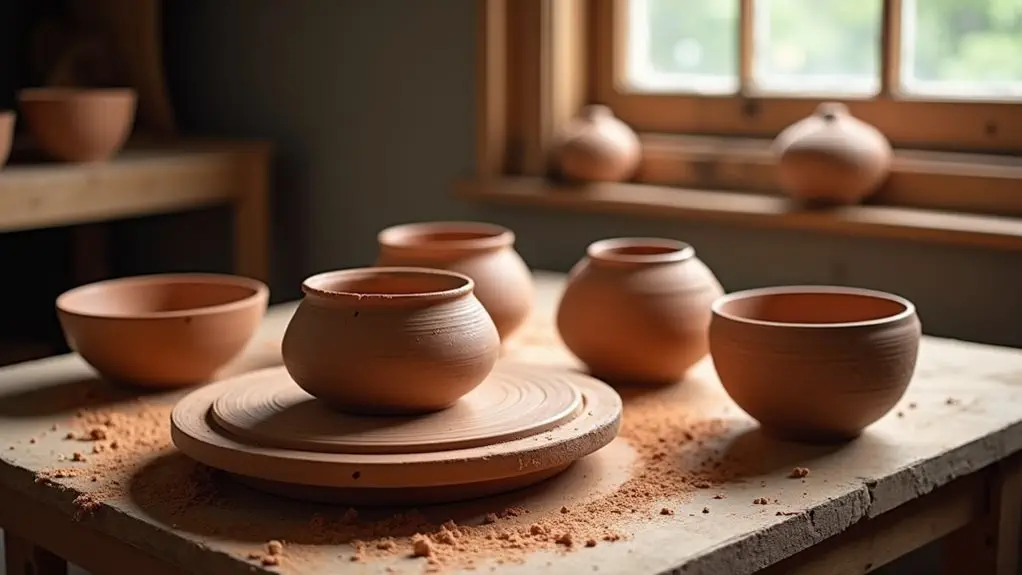
While pottery dates back over 30,000 years, artisanal ceramics truly began to flourish around 28,000 BCE with ceremonial figurines.
You'll find it fascinating how historical techniques evolved as pottery spread across Eastern Asia between 18,000 and 14,000 BCE, leading to groundbreaking developments in ceramic evolution.
The Neolithic period brought significant advancement as artisans developed low-temperature firing techniques and simple decorative patterns.
Types of Clay Pottery
Modern pottery continues the rich traditions established thousands of years ago, with different clay types offering unique possibilities for artisans. The earliest earthenware pieces were fired in pits between 29,000 to 25,000 B.C.
You'll find four main clay types that define today's pottery techniques: earthenware, stoneware, ball clay, and porcelain. Each has its own personality – earthenware's perfect for beginners with its forgiving nature, while stoneware's your go-to for durable everyday pieces that'll last for years. Certain products, like Cheeky Porcelain Pumpkins, showcase the elegance and charm that porcelain can bring to seasonal decor.
If you're feeling ambitious, porcelain challenges even experienced potters but rewards you with stunning, translucent pieces that'll take your breath away. Ball clay's the team player, mixing well with others to improve their workability.
Whether you're crafting your first bowl or creating museum-worthy pieces, there's a clay type that'll match your creative vision.
Hand Building Methods

Long before the invention of the pottery wheel, artisans shaped clay vessels entirely by hand – a tradition that continues to thrive today through three main techniques: pinch pottery, coil building, and slab construction.
When you're exploring handbuilding techniques, you'll find each method offers unique creative possibilities.
Pinch pottery lets you shape vessels by simply pushing your thumb into a clay ball and pinching – it's perfect for beginners! These techniques are highly versatile forms that can enhance wheel-thrown pottery pieces.
Coil building involves stacking clay "ropes" to create taller pieces, while slab construction works wonderfully for angular forms like boxes and plates.
You'll need some basic pottery tools to get started, like a wire cutter, scoring tool, and rubber rib.
The best part? You can mix and match these methods to create pieces that'd be impossible to make on a wheel.
Wheel Thrown Pottery
The potter's wheel revolutionized ceramics by introducing a new way to shape clay with speed and precision. When you're wheel throwing, you'll combine centrifugal force with your own skillful control to create stunning pottery. Classes and workshops at places like The Crucible offer expert instruction for beginners.
Using specialized pottery tools like ribs and sponges, you'll transform a humble lump of clay into functional art.
Here's what makes wheel throwing so exciting:
- You can create perfectly symmetrical forms that'd be nearly impossible by hand.
- The spinning wheel allows you to work quickly and efficiently.
- You'll develop a meditative flow as you master centering and shaping.
- You're able to make multiple pieces with consistent dimensions.
Whether you're crafting everyday items like mugs and bowls or creating artistic vessels, wheel throwing offers endless possibilities for expressing your creativity through clay.
Traditional Firing Techniques
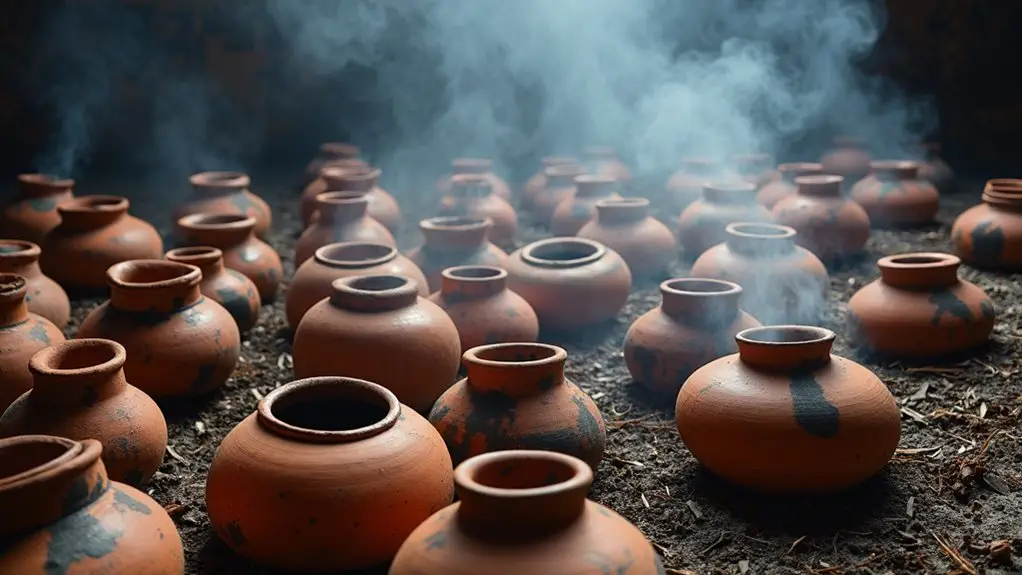
Since ancient times, potters have developed remarkable ways to transform raw clay into durable ceramics through traditional firing techniques.
You'll find that wood firing, while time-consuming, creates unique effects that can't be replicated by modern electric kilns. It's a labor of love that can take up to three days! Rich mixtures from wood kilns produce longer flames and sooty smoke that alter clay textures and colors.
Soda firing offers an innovative approach where you'll spray a mixture that creates its own mesmerizing glaze on the surface.
If you're feeling adventurous, raku firing delivers dramatic results as you plunge red-hot pottery into combustible materials, creating stunning crackle patterns.
For those who love getting back to basics, pit firing lets you connect with pottery's ancient roots – you'll dig a hole, nestle your pieces among organic materials, and let nature work its magic.
Glazing and Surface Decoration
Beautiful ceramic pieces come alive through glazing and surface decoration – a process that transforms raw pottery into vibrant, functional art.
You'll discover that glaze application isn't just about making pottery waterproof; it's about creating stunning visual effects that'll make your pieces stand out.
For optimal results, let glazes rest for 24 hours after mixing before beginning your decoration process.
Here are four exciting ways you can enhance your pottery's surface textures:
- Mix underglazes with patterns before adding your final glaze coat
- Create unique textures using materials like sand or wax resist
- Try syringe glazing for flowing, dramatic effects
- Experiment with layering different glazes for depth
Whether you're dipping, brushing, or spraying, each technique offers endless possibilities for creativity.
You can even combine methods to develop your signature style, making every piece uniquely yours.
Cultural Significance of Pottery
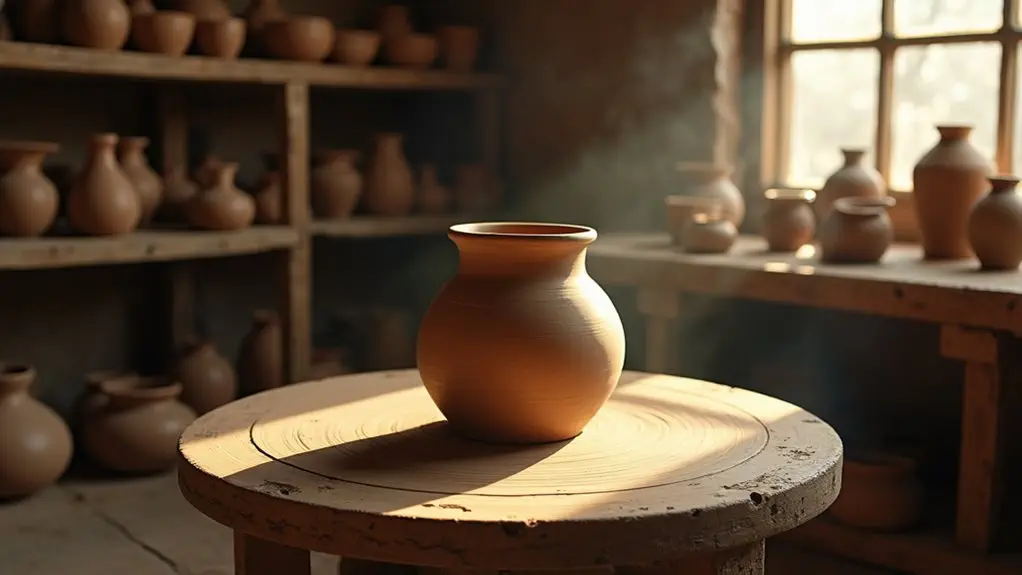
Throughout human civilization, pottery has served as more than just a practical craft – it's a powerful medium that tells the story of cultures worldwide.
You'll find that pottery rituals have played essential roles in societies, from Native American ceremonies to ancient Egyptian religious practices. The cultural symbolism embedded in each piece reflects the values, beliefs, and daily lives of communities across generations. Community gatherings and events often feature pottery-making activities that strengthen social bonds.
When you explore handmade pottery, you're connecting with traditions that have been passed down through centuries.
Today's artisans continue this legacy by blending time-honored techniques with contemporary innovations.
Whether you're admiring intricate patterns on a ceremonial vessel or using a handcrafted mug for your morning coffee, you're participating in a living tradition that bridges past and present, making history tangible in your everyday life.
Modern Handmade Pottery Trends
As handmade pottery evolves in the modern era, you'll notice exciting trends that blend traditional craftsmanship with contemporary innovation.
Today's potters are embracing sustainable pottery practices while pushing creative boundaries with innovative glazing techniques and digital tools. The rise of abstract patterns and swirls in modern pottery designs adds dynamic visual elements to contemporary collections.
Here's what's trending in modern handmade pottery:
- Eco-conscious creation using locally-sourced clays and energy-efficient kilns
- Experimental glazing that combines traditional methods with bold, contemporary colors
- Personalized pieces featuring custom monograms and made-to-order designs
- Digital integration, including 3D-printed patterns and technology-assisted forms
You'll find today's pottery scene is a fascinating mix of old and new, where ancient techniques meet modern sustainability.
Whether you're drawn to minimalist designs or organic textures, there's a style that perfectly matches your contemporary taste while honoring pottery's rich heritage.
Collecting and Identifying Pottery
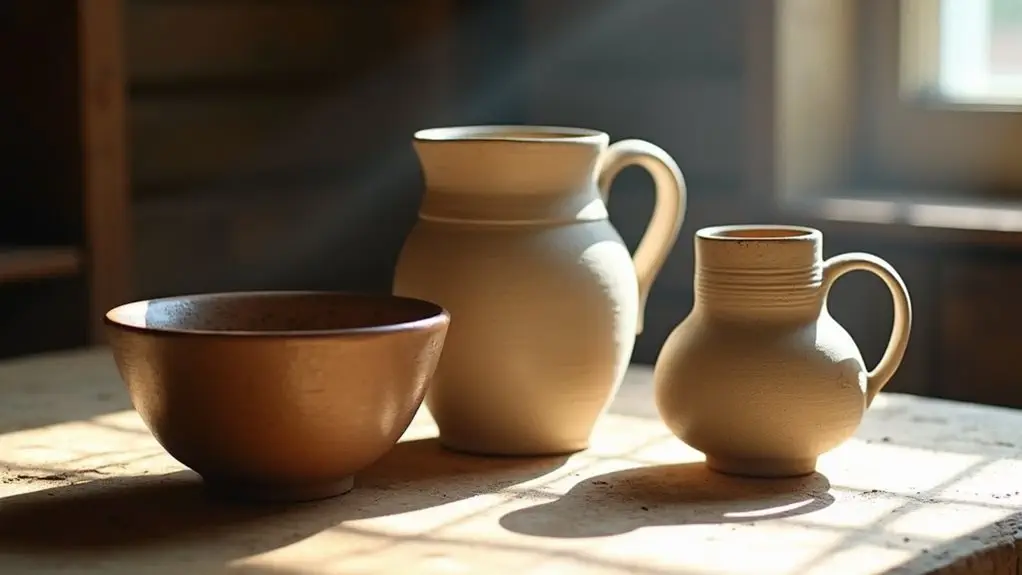
When you're collecting handmade pottery, knowing how to identify authentic pieces is essential for building a meaningful collection.
You'll want to start by examining the basics: look for telltale signs of various pottery techniques, like fingerprints inside coiled pieces or the distinctive marks of hand-pinching. Handbuilding pottery dates back to 28,000 BCE.
Don't worry if you're not an expert yet – there are plenty of collector resources to help you learn.
Start by checking the base for studio marks and studying the piece's overall symmetry.
Handmade items often have charming imperfections that set them apart from mass-produced pieces.
You'll find that different clays, glazes, and firing methods can reveal fascinating details about a pot's origin.
Final Thoughts
Whether you're a seasoned collector or a curious beginner, the world of handmade pottery, from artisanal ceramics to wheel-thrown vessels, offers a treasure trove of artistic expression. Like fingerprints in clay, each piece tells its own story through distinctive marks, glazes, and textures. You'll find that understanding pottery's rich heritage and diverse techniques not only deepens your appreciation but also connects you to thousands of years of human creativity and craftsmanship.

